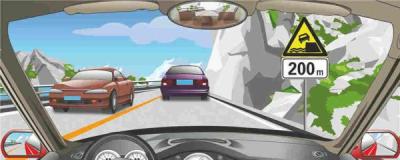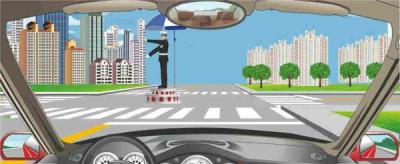1、Mr. He drove his large bus with 53 passengers (permitted carrying capacity 47) to 454 km mark by 100m along the Yining-hefei Expressway in Nanjing jurisdiction, where he was tailgated by a heavy-type semitrailer tractor. The bus left the road, breaking through the guardrail and catching fire. 17 people were killed and 27 injured. Which of the following law-breaking acts did Mr. He commit?
A、Speeding
B、Exceeding the carrying capacity of the motor bus
C、Driving a motor vehicle overdue for annual inspection
D、Improper operation
Answer:B
2、When parking for a long time on an upward slope due to breakdown on the road, drivers should use this method to stop up wheels.

A、Right
B、Wrong
Answer:B
3、If the road condition behind is good, motor vehicle drivers should reverse rapidly.
A、Right
B、Wrong
Answer:B
4、The sign on the right warns of an embankment road 200 meters ahead.

A、Right
B、Wrong
Answer:A
5、When a wounded person suffering burns is thirsty, he should only drink plain boiled water.
A、Right
B、Wrong
Answer:B
6、The crosswalk of the intersection warns that pedestrians have priority.

A、Right
B、Wrong
Answer:A
7、What should the driver do when seeing these hand signals?

A、Go straight and pass through the intersection
B、Stop in front of the stop-line and wait
C、Turn left at the intersection
D、Drive at a lower speed at the intersection
Answer:C
8、When there is bleeding at the bone fracture of a wounded person, the first thing to do is to fix the wounded part in position, then stop the bleeding and dress the wound.
A、Right
B、Wrong
Answer:B
9、Under such circumstances, what should motor vehicle drivers do?

A、Continuously sound the horn
B、Pass quickly
C、Pass at a lower speed
D、Bypass from either side
Answer:C
10、Mr. Tang drove a large bus with 74 passengers (capacity 30 people). When descending a long curving slope at a speed of 38 kilometers per hour, the bus overturned to a brook beside the road. As a result of the accident, 17 people were killed and 57 people injured. What's the main illegal act committed by Mr. Tang?
A、Driving after drinking
B、Carrying more passengers than permitted
C、Fatigued driving
D、Speeding
Answer:BD
11、When there is a sudden braking failure on a downhill road, what should be done by the driver?
A、Driving to an emergency lane and reducing speed to stop
B、Dropping the gear by two positions
C、Changing to the reverse gear to force the vehicle to stop
D、Reducing speed by pulling up the handbrake
Answer:A
12、The driver may not yield when the motor vehicle encounters this situation at the intersection.

A、Right
B、Wrong
Answer:B
13、After a motor vehicle enters the ramp from an expressway, it should reduce its speed below the prescribed speed limit.
A、Right
B、Wrong
Answer:A
14、When driving on an expressway which of the following statements is correct?
A、Drivers may stop to pick up or drop off passengers in the emergency lane
B、Drives may load or unload cargo in the emergency lane
C、Drives may overtake other vehicles or stop in the deceleration or acceleration lane
D、Drives are prohibited from driving or stopping in the emergency lane in a non-emergency case
Answer:D
15、The distance-ascertaining section of an expressway is used for the drivers to ascertain the safety distance when the speed is 100 kilometers per hour.

A、Right
B、Wrong
Answer:A
16、When a motor vehicle deviates from the normal direction due to steering failure, what should the driver do?
A、Immediately steer and adjust
B、Reduce speed and stop the vehicle as early as possible
C、Steer to the side where there is no obstacle to evade
D、Steer to the side where there is an obstacle to evade
Answer:B
17、The driver should speed up to 40 kilometers per hour when he/she sees this traffic sign.

A、Right
B、Wrong
Answer:B
18、If a fast moving vehicle has a steering failure, using emergency braking can easily cause an overturn.
A、Right
B、Wrong
Answer:A
19、When rescuing a wounded person who has been poisoned by toxic gas, which of the following measures should be taken first?
A、Prevent heat loss
B、Bring him/her to a place with fresh air
C、Give him/her artificial respiration
D、Depress the heart over the chest
Answer:B
20、The sign in front indicates a one-way lane after turning left.

A、Right
B、Wrong
Answer:A
21、The motor vehicle should slow down and pass slowly in this situation.

A、Right
B、Wrong
Answer:A
22、The sign on the right warns of a non-motor vehicle lane.

A、Right
B、Wrong
Answer:B
23、When rescuing a wounded person who has been poisoned by toxic gas, the first measure is to send him/her to a place with fresh air so that he/she will not continue to be poisoned.
A、Right
B、Wrong
Answer:A
24、When driving on this dangerous mountainside road motor vehicle drivers should drive along the left side of the road.

A、Right
B、Wrong
Answer:B
25、What should the driver do if he/she wants to turn left at this intersection?

A、Turn left along the straight-going lane
B、Enter the left turn waiting area
C、Enter the straight-moving waiting area
D、Turn left along the left lane
Answer:B